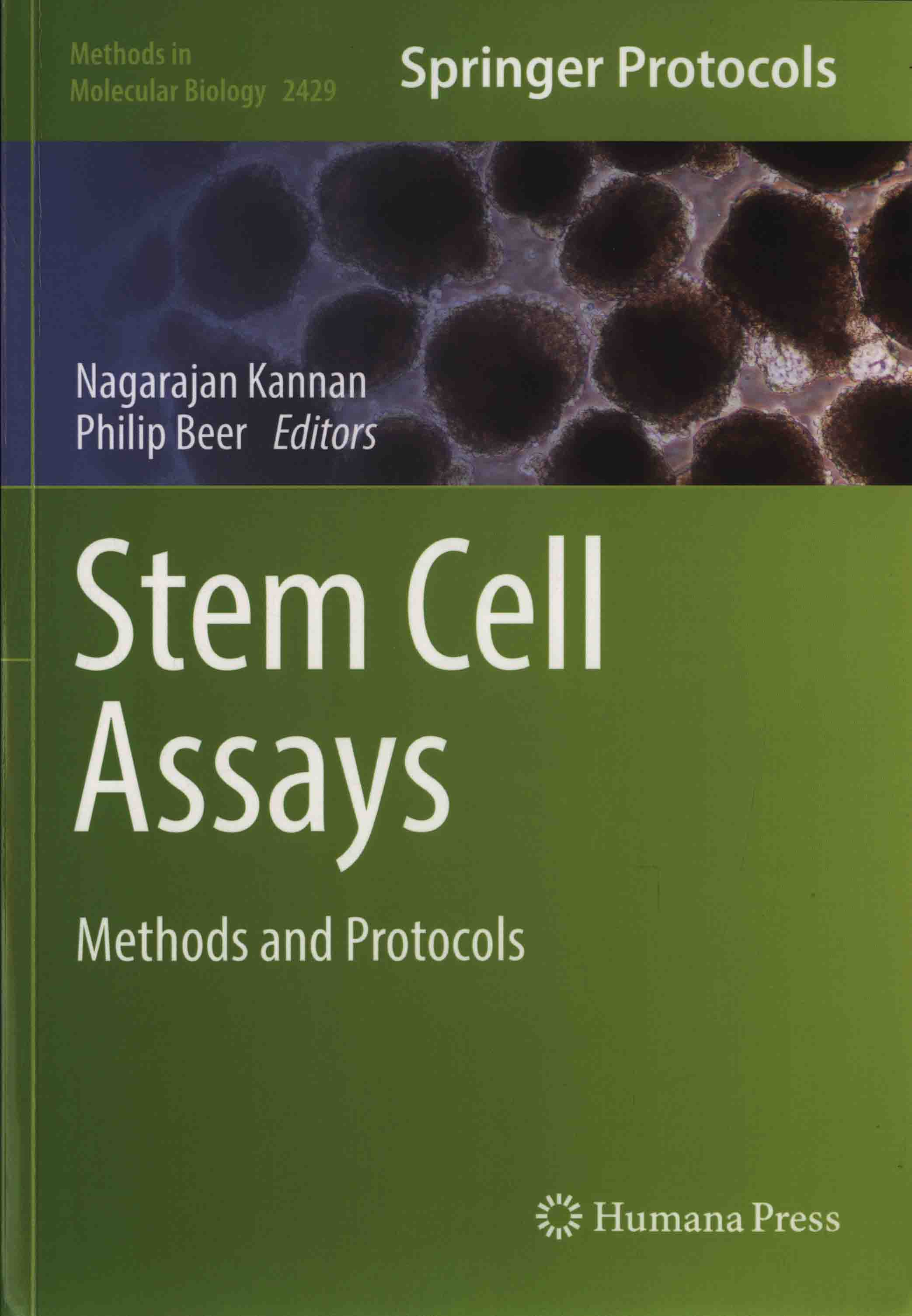 |
Stem cell assays : methods and protocols / edited by Nagarajan Kannan, Philip Beer. -- New York, NY : Humana Press, 2022. – (58.17/M592/v.2429) |
Contents
Preface
Contributors
PART I ES/IPS
1 Rapid and Highly Efficient Isolation and Purification of Human Induced Pluripotent Stem Cells
2 Artificial Activation of Murine Oocytes Using Strontium to Derive Haploid and Diploid Parthenotes
3 Generation of Human iPSC from Small Volume Peripheral Blood Samples
4 Distinguishing Between Endodermal and Pluripotent Stem Cell Lines During Somatic Cell Reprogramming
5 Measuring Early Germ-Layer Specification Bias in Human Pluripotent Stem Cells
6 Detection of Soluble and Insoluble Protein Species in Patient-Derived iPSCs
7 Extracellular Flux Analysis of Mitochondrial Function in Pluripotent Stem Cells
8 Assessment of Endothelial-to-Hematopoietic Transition of Individual Hemogenic Endothelium and Bulk Populations in Defined Conditions
PART II ES/IPS DERIVED TISSUE STEM CELLS
9 Homogeneous Differentiation of Functional Hepatocytes from Human Induced Pluripotent Stem Cells
10 Differentiation of Human Induced Pluripotent Stem Cells into Cortical Neurons to Advance Precision Medicine
11 Differentiation of iPS-Cells into Peripheral Sensory Neurons
12 Culture of Human iPSC-Derived Motoneurons in Compartmentalized Microfluidic Devices and Quantitative Assays for Studying Axonal Phenotypes
13 iPS Cell Differentiation into Brain Microvascular Endothelial Cells
14 Chromatin Immunoprecipitation in Human Pluripotent Stem Cell-Derived 3D Organoids to Analyze DNA-Protein Interactions
15 Generation of Embryonic Origin-Specific Vascular Smooth Muscle Cells from Human Induced Pluripotent Stem Cells
16 Generation of Salivary Gland Organoids from Mouse Embryonic Stem Cells
17 In Vitro Generation of Heart Field Specific Cardiomyocytes
PART III TISSUE STEM CELLS
18 Isolation and Characterization of Extracellular Vesicles Derived from Human Umbilical Cord Mesenchymal Stem Cells
19 Identification and Validation of CRISPR/Cas9 Off-Target Activity in Hematopoietic Stem and Progenitor Cells
20 Genome Engineering of Hematopoietic Stem Cells Using CRISPR/Cas9 System
21 Generation of Rat Neural Stem Cells to Produce Different Astrocyte Phenotypes
22 In Situ Quantification and Isolation of Muller Glial Cells by Fluorescence-Activated Cell Sorting from the Regenerating Larval Zebrafish Retina
23 Quantification and Clonal Culture of Neural Stem Cells from the Hippocampus of Adult Mouse
24 Reprogramming Mouse Oviduct Epithelial Cells Using In Vivo Electroporation and CRISPR/Cas9-Mediated Genetic Manipulation
25 Generation of Human Liver Chimeric Mice and Harvesting of Human Hepatocytes from Mouse Livers
26 Application of 3D Culture Assays to Study Breast Morphogenesis, Epithelial Plasticity, and Cellular Interactions in an Epithelial Progenitor Cell Line
27 A Unified Protocol to Streamline Molecular and Cellular Analysis for Three-Dimensional Cell Cultures
28 Mesenchymal Stem Cell Seeding on 3D Scaffolds
29 Assaying Candidate Human Skin Keratinocyte Stem Cells by Determining Their Long-Term Serial Proliferative Output in Culture
30 Protocol for the Detection of Organoid-Initiating Cell Activity in Patient-Derived Single Fallopian Tube Epithelial Cells
31 Quantification of Muscle Stem Cell Differentiation Using Live-Cell Imaging and Eccentricity Measures
PART IV MALIGNANCY
32 The Enrichment of Breast Cancer Stem Cells from MCF7 Breast Cancer Cell Line Using Spheroid Culture Technique
33 Assessment of Breast Cancer Stem Cell Activity Using a Spheroid Formation Assay
34 Enrichment of Cancer Stem Cells in a Tumorsphere Assay
35 In Vitro Quantification of Cancer Stem Cells Using a Mammosphere Formation Assay
36 Designing Genetically Engineered Mouse Models (GEMMs) Using CRISPR Mediated Genome Editing
37 Assays for the Spectrum of Circulating Tumor Cells
38 Limiting Dilution Tumor Initiation Assay: An In Vivo Approach for the Study of Cancer Stem Cells
39 Orthotopic Xenografts of Colorectal Cancer Stem Cells
Index